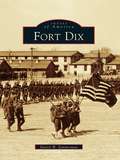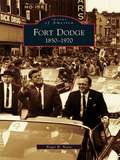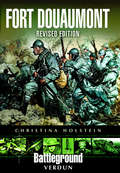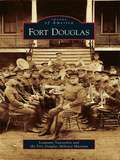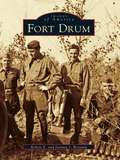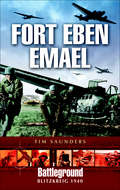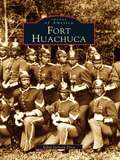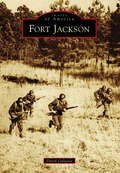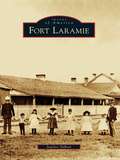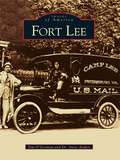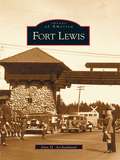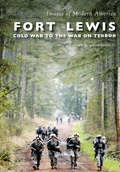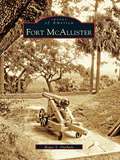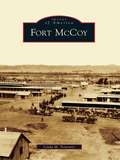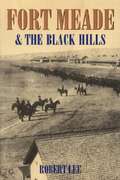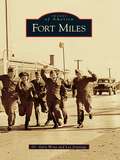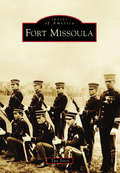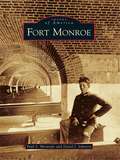- Table View
- List View
Fort Devens (Images of America)
by William J. CraigThe geographical location of Fort Devens has a military history that dates back to the 1600s, when the area was first garrisoned by British troops. In 1915, the region was again chosen for a cantonment, one of only sixteen in the country. In order to build the camp, the War Department assembled the largest labor force in history. New buildings sprang up at the rate of about ten per day and supported more than one hundred thousand troops that were processed at Camp Devens, as it was originally named, during World War I.Fort Devens is the first book to trace the military activity in this area. Throughout the twentieth century, troops were trained and deployed from Fort Devens for every major conflict the United States was involved in. During World War II, Fort Devens inducted more than six hundred thousand men into the army from the New England area. The list of individuals who have served here included Pulitzer Prize-winning cartoonist Bill Mauldin, Secretary of State Colin L. Powell, and Senator Edward M. Kennedy. Even NASA can trace its birth to Fort Devens by way of Dr. Robert Goddard's liquid-fueled rocket experiments.
Fort Dix (Images of America)
by Daniel W. ZimmermanLocated in central New Jersey, Fort Dix has been training soldiers since its founding in 1917. More than three million men and women have passed through its gates since it was built as one of the original sixteen army camps to train and mobilize soldiers for World War I. Using historical images, Fort Dix chronicles the history of life in an army camp from 1917 to the present. The fort, once known as Camp Dix, has experienced many changes over the years. This unprecedented photographic history traces the evolution from a wooden cantonment to the installation of brick and fiber optics, from a horse-dominated transportation system to a motor vehicle system, and from training recruits to serving Army Reserve and National Guard soldiers. Along the way, Fort Dix depicts the influence of the 78th Division, the Civilian Conservation Corps, the Women's Army Corps, Desert Storm, and the humanitarian work of resettling the Kosovo refugees.
Fort Dodge: 1850 to 1970
by Roger B. NatteFort Dodge was founded in 1850 as a military post to police the Iowa frontier. A subsequent land boom created fortunes that were reinvested in the local economy. The town soon earned the nickname "Mineral City" because of the extensive deposits of coal, gypsum, limestone, and clay. By 1900, the city was a rail center and the world's largest producer of gypsum products. With a highly diversified economy, the city prospered and by World War I was able to claim to have more skyscrapers per capita than any other city in the Midwest and beautiful public buildings designed by some of the nation's leading architects. Between 1900 and 1925, Fort Dodge enjoyed the role as an important political center and the home of two U.S. senators, the director of the U.S. Mint, the solicitor of the Department of the Treasury, a judge on the U.S. Court of Appeals, Eighth Circuit, and the first presidential press secretary and speechwriter. Sons and daughters of the community went on to establish national reputations in art, music, literature, science, and journalism. Images used in this volume come primarily from the archives of the Webster County Historical Society and were chosen to represent the changing character of the community from 1850 to 1970.
Fort Douaumont: Revised Edition (Battleground Verdun)
by Christina HolsteinA WWI guide &“rich in personal experiences from French and German sources . . . a vivid, yet sometimes ghastly, account of the fighting for the fort&” (Burton Mail). The Battle of Verdun, which lasted from 21 February to 15 December 1916, was a turning point in the First World War, and Fort Douaumont was at the heart of it. In 1914 the fort was the strongest and most modern of the fortifications around Verdun and it formed the keystone of the French defense in the area. Using both French and German sources, Christina Holstein introduces the reader to the fortress system around Verdun, explains the construction, reinforcement and armament of Fort Douaumont and describes its surprise capture by the Germans in February 1916. Its loss was a terrible blow to French morale and their repeated attempts to retake the fort are portrayed in graphic detail. As the months ground on and the Battle of Verdun turned into stalemate, the desire to keep or to recapture Fort Douaumont, whatever the cost, became the reason for both sides to go on fighting. Now fully up-to-date, this guide gives a compelling insight into the brutal nature of the struggle and into the soldiers who took part in it and will be essential reading for students of the Battle of Verdun, for visitors to the battlefield, and for anyone who is interested in the history of twentieth-century fortifications. &“Much more than a battlefield guide . . . The plans and campaign maps are clear and easy to follow, and the text is accompanied by some excellent photographs.&”—Fortress Study Group
Fort Douglas (Images of America)
by Louwane Vansoolen Fort Douglas Military MuseumOn October 26, 1862, Col. Edward P. Connor and the 3rd California Volunteers set up Camp Douglas for the purpose of protecting the overland mail and telegraph routes between Nevada and Wyoming. This began a long history of a U.S. military presence in the Salt Lake Valley Mormon community. Although the camp closed on October 26, 1991, the U.S. military still has a presence today on the east bench of Salt Lake City known as Fort Douglas. The base as it was during its heyday of the 38th Infantry is gone, but the parade ground and Gothic sandstone homes of Officers Circle, shaded by trees planted long ago, still remain at Fort Douglas. The horses have disappeared and the "old soldiers have faded away," but the stable and red-brick barracks also remain. A few old-timers still enjoy a stroll around the parade ground, listening for the canyon breeze ruffling through the trees that echo faintly the calls of yesteryear.
Fort Drum (Images of America)
by Robert E. Brennan Jeannie I. BrennanNorthern New York State has boasted a prominent military presence since the War of 1812. Beginning in 1816 with the establishment of Fort Drum's predecessor, Madison Barracks, troops have trained there throughout the summer months and the harsh winters. Today, Fort Drum is the largest military facility in the northeastern United States, home to the 10th Mountain Division, a tactical unit deployed on missions around the world. Beginning with the history of Madison Barracks, Fort Drum depicts its birth as Pine Plains, a ten-thousand-acre training area, and its continued evolution into a military asset. By 1908, soldiers from Madison Barracks began summer maneuvers at Pine Plains under the command of Brig. Gen. Frederick Dent Grant, son of Gen. Ulysses S. Grant. Historic images in Fort Drum show these training camps and what are known today as the greatest military maneuvers in peacetime history during 1935. Today, Fort Drum supports the training of almost eighty thousand troops annually. This striking volume presents the military history of Fort Drum and the missions it continues to support in defense of the United States.
Fort Eben Emael
by Hugh Johnson Simon DunstanAt the outbreak of World War II, Fort Eben Emael in Belgium was the strongest fortress in the world, and it lay exactly across the German invasion route of Belgium and France. The fort's elimination was essential for the success of Hitler's invasion of the West. Deemed impregnable to conventional attack, Hitler himself suggested the means for its capture with the first glider-borne assault in military history. On 10 May 1940, ten gliders carrying just 77 paratroopers landed on top of the fort. Using top-secret hollow-charge weapons for the first time in warfare, the assault pioneers of Sturmgruppe Granit subdued Fort Eben Emael within just 30 minutes, and the fortress surrendered within 30 hours. It remains one of the greatest raids in the annals of Special Forces.
Fort Eben Emael 1940 (Battleground Blitzkrieg 1940)
by Tim SaundersThis WWII battlefield guide offers a detailed history of the Siege of Fort Eben Emael during the Nazi invasion of Belgium—with maps and photos throughout.On May 10th, 1940, German forces launched an attack on Fort Eben Emael on the Belgian-Dutch border. The seizure of the fortress stronghold by German Airborne and Special Forces was the dramatic opening shot in the Nazis' devastating Belgian Campaign. Codenamed Operation GRANITE, it involved glider forces in a daring "coup de main" operation achieving total surprise and success. This comprehensive guide to the Fort Eben Emael battleground offers extensive background information on the fort itself and the significance of the Nazi offensive. A detailed account of the two-day battle is supported by numerous photographs and maps. The simultaneous assaults on key bridges on the Albert Canal are also covered in graphic detail.
Fort Hood in World War II (Images of America)
by David FordOn January 14, 1942, Col. Andrew D. Bruce announced that the location of the new Tank Destroyer Tactical Training and Firing Center was to be near Killeen, Texas. This announcement put into motion a whirlwind of activity and construction that resulted in the creation of one of the largest military bases in the world. On September 18, 1942, Camp Hood was officially opened. Eight short months after the opening of Camp Hood, the base nearly doubled in size. Building from scratch, the spirit of a black panther, as depicted on the tank destroyers shoulder patch, was channeled into anti-tank combat teams. These teams were trained to fight the formidable might of Germany's panzer divisions.
Fort Huachuca (Images of America)
by Ethel Jackson PriceAt the foot of the Huachuca Mountains, the U.S. Army founded one of the most crucial military posts for American expansion into the southwest frontier. Soldiers had been stationed in the region for decades, but in 1877 Fort Huachuca became the symbolic cornerstone of America's western domain. The Native American word huachuca, meaning "place of thunder," described the sporadic but marvelous electrical storms in the area, but the skies would not be the only thing booming. During the tumultuous campaigns to resolve American and Indian disputes, the U.S. infantry and famed Buffalo Soldiers faced off with Geronimo and his Apache nation in both tense negotiations and bitter combat. As time marched on, the fort developed into a permanent installation with barracks, modern training grounds, and other facilities to accommodate troop rotations and eventually became the innovative Center for Military Intelligence.
Fort Jackson (Images of America)
by David GalassieFort Jackson is a sprawling military base east of Columbia, South Carolina. With the impending entry of America into World War I, city fathers recognized the country's need for military training camps and made a successful proposal to the US Army for construction of a camp near Columbia. Named after Andrew Jackson, the hero of the Battle of New Orleans and the seventh US president, Camp Jackson soon became the home of the famous 81st "Wildcat" Division and, later, the 5th Infantry Division. Over time, the camp's prospects waned, but the advent of another world war brought renewed interest in the camp and its eventual designation as Fort Jackson in 1940. Fort Jackson has been instrumental in the mobilization and training of troops for service in the Korean War, the Vietnam War, and the Global War on Terror. Today, Fort Jackson is the Army's premier basic training installation, responsible for over 50 percent of Army trainees each year.
Fort Knox: Protecting the U.S. Gold Reserves (High Security)
by Lisa HarkraderThe United States keeps its gold safe at Fort Knox. How is this done? There are fences, locks, guards, and more. Learn more about this high-security place!
Fort Laramie
by Starley TalbottFort Laramie was one of the most important frontier outposts of the American West. Founded as the trading post Fort William in 1834, the fort became a U.S. military post in 1849. Beginning in 1841, emigrants stopped at Fort Laramie while traveling the Oregon, California, and Mormon Trails. Fort Laramie served as a gathering place for thousands of Native Americans and hosted the 1851 and 1868 treaty councils. When the treaties failed, the post became the staging area for campaigns that eventually led to the tribes's confinement on reservations. Fort Laramie was abandoned by the military in 1890; the buildings were auctioned and served private interests during the homestead period from 1890 to 1937. Fort Laramie was acquired by the state of Wyoming in 1937, and the fort became a unit of the National Park System in 1938. Fort Laramie National Historic Site is open daily except New Year's Day, Thanksgiving, and Christmas. The restoration of many structures to their historical appearance provides visitors with a glimpse of the past.
Fort Laramie: Military Bastion of the High Plains
by Douglas C. McchristianMcChristian (author and retired historian, National Park Service) provides a complete military history of Fort Laramie, one of America's most venerated historic places. The book details every stage of the fort's existence, from its beginnings in 1834 as a trading post, its involvement in the buffalo hide trade, overland migrations, Indian wars and treaties, the Utah War, and into the telegraph and first transcontinental railroad eras. It also includes previously untold stories, such as the 1874 murder of Lieutenant Levi Robinson. The book also includes photographs of the fort, its surroundings, and the personalities who were involved with it. Annotation ©2009 Book News, Inc., Portland, OR (booknews.com)
Fort Lee (Images of America)
by Tim O’gorman Dr Steve AndersFort Lee, located adjacent to the Petersburg Civil War Battlefield, is the designated Home of the United States Army Quartermaster Corps. The first Camp Lee, established as a National Army Cantonment in 1917, trained the 80th Division for service in France. In 1940, Camp Lee was reestablished, and since World War II, has trained hundreds of thousands of Quartermasters, whose numerous skills include military supply, water and petroleum operations, Army field feeding, and parachute rigging for "supply by sky." Fort Lee is also the home of the Defense Commissary Agency and the Army Logistics Management College, which provides advanced schooling for Armed Forces logisticians. For over 60 years, Fort Lee has played a vital role ensuring that America's Army is the best-equipped and most well-supported army in the world.
Fort Lesley J. McNair (Images of America)
by John MichaelFrom southeast Washington, DC, where the Potomac and Anacostia Rivers meet, this fort has continued to protect America's capital. In 1791, Pierre L'Enfant designated it as a military reservation. The post is the third oldest in continuous operation--as an arsenal, a penitentiary, a hospital, and now, a military education center. It was renamed in 1948 to honor Lt. Gen. Lesley J. McNair, who was killed in World War II. Over the course of two centuries, the fort has born witness to the British ransacking during the War of 1812; a Civil War explosion that killed female arsenal workers; and the incarceration, trial, and hanging of Lincoln assassination conspirators. Over time, it became the home of several artillery commands, the first federal penitentiary, the US Army Engineer School, the US Army Music School, the US Army War College, and the US Army Band ("Pershing's Own"). Today, it has evolved into the National Defense University, Inter-American Defense College, and the headquarters of the Military District of Washington.
Fort Lewis: Cold War To The War On Terror (Images of America)
by Alan H. ArchambaultThe area now known as Fort Lewis was first recognized for its potential as a military reservation in the early 1900s when a series of militia and national guard encampments were held in the area. Camp Lewis was established as the United States entered World War I in 1917 and became the first Army installation in the history of the nation to be created as a direct result of the outright gift of land by private citizens. During World War I, Camp Lewis became the largest military post of the era. Here, thousands of "doughboys" trained for the Great War and began a tradition of training excellence that continues to this day. In 1927, the camp was designated a permanent post and offically became Fort Lewis.The story of this important military installation is told here in a series of historic photographs, from the collections of Fort Lewis Military Museum dating from the early 20th century to the present. The photographs capture not only the natural beauty of the area and prominent buildings, but also many of the men and women who have served their nation at Fort Lewis.
Fort Lewis: Cold War to the War on Terror (Images of Modern America)
by Alan H. ArchambaultCamp Lewis was established in 1917 as a training camp for the US Army in World War I. Made a permanent post in 1927, Fort Lewis became an important base for training and sending soldiers to combat in World War II and the Korean War. In 1956, the 4th Infantry Division arrived at Fort Lewis while America was deeply committed to protecting democracy around the world during the Cold War. From that time forward, Fort Lewis has been in the forefront of military reservations in the United States. The post played a crucial role in the Vietnam War, Operations Desert Shield and Desert Storm, and the War on Terror. Soldiers based at Fort Lewis have deployed to conflicts throughout the world in defense of freedom. Today, Fort Lewis remains on the cutting edge of America's sword.
Fort McAllister: Fort Mcallister, Georgia, In The Civil War And Beyond (Images of America)
by Roger S. DurhamMany earthen fortifications defended the city of Savannah and its numerous water approaches after the Civil War broke out. One of these defenses, Fort McAllister, protected the entrance to the Ogeechee River and the strategic railroad and highway bridges upstream. From November 1862 to March 1863 the U.S. Navy bombarded the fort seven different times without success. The fort finally fell to General Sherman in December 1864; ironically, the final threat the fort faced was not from an enemy trying to get up the river, but from one trying to get down the river to the sea. In the 1920s auto magnate Henry Ford renovated the fort and focused new attention on its history.
Fort McCoy (Images of America)
by Linda M. FournierFrom the days of the horse-drawn caisson to today's Humvee, Fort McCoy has played a vital role in the military readiness of America's armed forces. The only federal military installation within the state of Wisconsin, Fort McCoy has seen more than five million military personnel from throughout the UnitedStates pass through its gates since its founding in 1909. Fort McCoy exists today primarily because its founder, Maj. Gen. Robert B. McCoy, foresaw that the U.S. Army would need a regional site at which to train and maneuver and then dedicated himself to making that vision a reality. Fort McCoy's mission ofsupporting training and mobilization has remained constant from those early days on the McCoy ranch to the current global War on Terror. This book chronicles the illustrious history of Fort McCoy from the doughboys of World War I to today's soldiers supporting Operations Enduring Freedom and Iraqi Freedom.
Fort Meade and the Black Hills
by Robert LeeFort Meade was the home of the famous Seventh Cavalry after its ignominious defeat in the Battle of the Little Bighorn. Troops from Fort Meade played a pivotal role in the events that led to the tragedy at Wounded Knee in 1890. It was the scene of imprisonment of Ute Indians who made the mistake of interpreting their new citizenship status as freedom from government control. The fort survived the mechanization of the horse cavalry, aided the record-breaking Stratosphere Balloon flight of 1935, and became a training site for the nation's first airborne troops. Fort Meade existed for sixty-six years, from 1878 to 1944. Robert Lee examines the strategic importance of its location on the northern edge of the Black Hills and the role it played in the settlement of the region, as well as the role played by the citizens of Sturgis in keeping it alive. One of the chief delights of Fort Meade and the Black Hills is a gallery of characters including the unfortunate Major Marcus Reno, the beautiful and fatal Ella Sturgis, and the cigar-smoking Poker Alice Tubbs. They, and events scaled to their larger-than-life size, are part of this long overdue story of Fort Meade. Robert Lee has published several books and many articles on South Dakota's history. Inducted into the South Dakota Hall of Fame in 1987, he was named its writer of the year in 1992.
Fort Miles (Images of America)
by Lee Jennings Dr Gary WrayFort Miles is in Cape Henlopen State Park near historic Lewes and the site of Delaware's first Dutch settlement. Named for Gen. Nelson Appleton Miles, this powerful seacoast fortification was built during World War II to defend the vital industries of the Delaware Valley. Included in this volume are rare vintage photographs of the fort's heavy artillery, hundreds of 3,000-pound sea mines, and radar systems that searched the nearby ocean for the enemy surface fleet. Its powerful 12- and 16-inch guns could reach out between 15 and 25 miles to attack an adversary. Today, the fort is being reborn as one of the best World War II museums in the country; it is housed in a real World War II bunker and includes the barracks complex and fire control towers.
Fort Mill (Images of America)
by Leanne Burnett MorseMore than 250 years ago, near the border where the Carolina colony was divided into north and south, Catawba Indians welcomed the first white settlers to the riverbank at the Nation Ford, and the seeds of a town were sown. Since that time, the area that would become Fort Mill Township has persevered and prospered. From its early days, when Scots-Irish immigrants built the gristmill that gave the town its name, to the explosive growth of the 21st century, the story of Fort Mill has been written by larger-than-life characters like Col. Elliott White Springs, heroic Medal of Honor recipients, resilient cotton farmers, dedicated educators, determined civil rights advocates, and proud mill workers. Fort Mill has set itself apart as a place with a distinct personality and an enduring legacy. Self-sufficiency, Southern grit, and small-town values are just a few of the distinguishing characteristics of this unique town.
Fort Missoula (Images of America)
by Tate JonesBorn of perceived military necessity and local economic boosterism, "the beautiful little post on the Bitterroot" provided a home for the US Army in Montana from 1877 onward. Called into service almost by accident for the 1877 Nez Perce War, Fort Missoula hosted African American Buffalo Soldiers, aviation pioneers, early military automobile mechanics, Civilian Conservation Corps workers, World War II Italian and Japanese national internees, US military prisoners, and a variety of US Army and Navy units. The base bequeathed to its community a level of sophistication and a connection to the national story unique to the American West. Fort Missoula's architectural legacy also reflects the nation's journey from frontier settlement to world power as an assortment of log structures evolved into "the Million Dollar Post."
Fort Monroe (Images of America)
by David Jeffrey Johnson Paul MorandoFort Monroe was once a powerful symbol of America's national defense system. From 1823 to 1945, its primary military mission was to protect Hampton Roads and the entrance to the Chesapeake Bay from enemy attacks. Over the years, as military technology advanced, Fort Monroe's defensive posture changed. To counter potential threats, American coastal defense installations such as Fort Monroe developed sophisticated steel disappearing guns, mortars, anti-aircraft weapons, and submarine mines. As the site of the army's Coast Artillery School, Fort Monroe trained thousands of soldiers. After World War II, Fort Monroe's role as a coastal defense installation ended, and the post took on new missions as a training headquarters facility. With more than 200 original photographs, this volume unveils the layered history of this massive stone-and-brick installation from the end of the Civil War to the present. This volume will highlight more than 140 years of images that capture Fort Monroe's varied missions, historic buildings, the families who lived there, the resort hotels, and other aspects of this unique national landmark.

